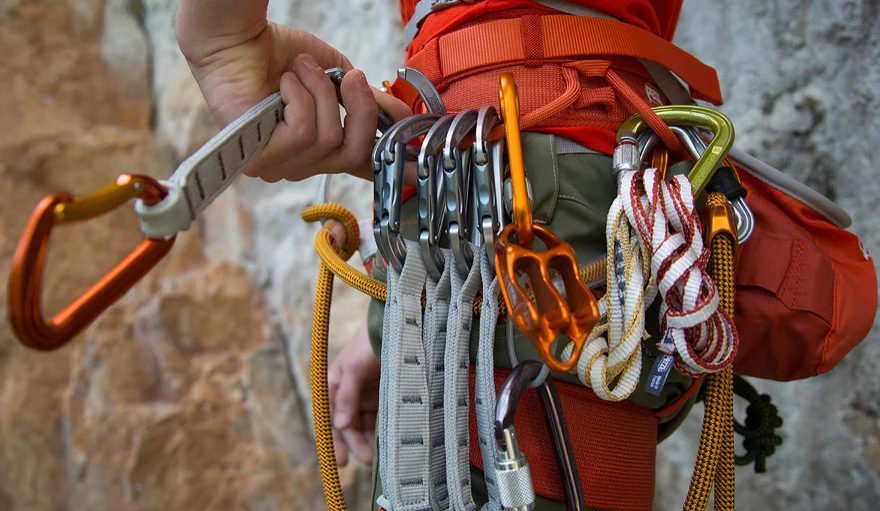This climbing vocabulary covers key techniques, equipment and grades to enhance your climbing experience.
Engaging in climbing provides a social full-body workout and stress relief, making it an ideal after-work hobby. Whether you’re ascending walls or cliffs, understanding climbing vocabulary is crucial for successful climbs, connecting with fellow enthusiasts, and selecting the right gear.
This blog post defines key climbing techniques, equipment, grades, and slang, offering insights to enhance your experience in this exhilarating activity.
What is your English level?
Find out your A1 A2 B1 B2 C1 C2 level of English with our online test and receive your English certificate.
Basic climbing vocabulary
Let’s begin this climbing terminology guide with the essential basics that every climber should be familiar with.
Climbing gear
- Crimp
- Harness
- Pinch
- Climbing shoes
- Sloper
- Carabiner
- Belay device
- Quickdraw
- Chalk
- Handholds
- Edge
- Sloper

Basic climbing techniques
- Footwork
- Belaying
- Route
- Lead climbing
- Top-rope climbing
Are you C1 Advanced English?
Get your C1 Advanced English certificate now!
✓ Add your certificate to your resume
⭐ ⭐ ⭐ ⭐ ⭐
Bouldering vocabulary
Now that you have a grasp of the fundamentals, let’s explore the vocabulary specific to bouldering, which is a style of climbing focused on ascending shorter rocks or walls without the use of ropes or harnesses. Gain a clear understanding of key bouldering terms, climbing equipment, and grading systems essential for gauging your skill level and progress.
Common bouldering terms
- Project
- Crash pad
- Mantel
- Boulder problem
- Spotting
- Dyno
Bouldering grades
Bouldering grades serve to convey the difficulty level of a boulder problem. Similar to acquiring the appropriate business abbreviations for your professional field, becoming proficient in this terminology can quickly elevate your expertise. Two main grading systems are employed for bouldering:
- V-scale (also known as Vermin or Hueco Scale): Originating in the United States, the V-scale spans from V0 (least difficult) to V17 (most challenging). As your climbing proficiency advances, you’ll encounter problems with higher V-grades, indicating greater complexity.
- Fontainebleau (Font) scale: Developed in France, the Font scale is utilized in Europe and various global regions. It commences at 3 (least difficult) and progresses to 9A+ (most challenging), incorporating a mix of numbers and letters to signify different difficulty levels. For instance, 6A is easier than 6B, and 6B+ is more challenging than 6B but less difficult than 6C.

Sport climbing vocabulary
Learn the ins and outs of the vocabulary and grading systems specific to sports climbing, a climbing method that entails ascending pre-protected routes using fixed anchors and bolts.
Common sport climbing terms
- Route setting: The process of strategically placing holds on a climbing wall to create routes for climbers.
- Whipper: A term denoting a dramatic fall taken by the lead climber when positioned above their last piece of protection, usually a quickdraw.
- Onsight: Accomplishing a route successfully on the initial attempt without prior knowledge or beta (information about the moves), and without experiencing falls or relying on the rope for support.
- Bolt: A permanent anchor embedded in the rock for securing the climbing rope as the climber ascends, often used in conjunction with quickdraws.
- Clipping: The action of attaching the climbing rope to a quickdraw, a device comprising two carabiners connected by a textile sling, which is in turn fastened to a bolt.
- Redpoint: Derived from the German “Rotpunkt,” this term signifies successfully climbing a route from start to finish without falling or resting on the protective gear, as exemplified in the inspiring Rotpunkt documentary featuring renowned climber Alex Megos.
- Onsight: Accomplishing a route successfully on the initial attempt without prior knowledge or beta (information about the moves), and without experiencing falls or relying on the rope for support.
Traditional climbing vocabulary
Brush up on essential terms, phrases, and words for this form of climbing that requires the lead climber to place their own removable protection, such as nuts and camming devices, as they ascend a route.
Common trad climbing terms
- Multi-pitch
- Rack
- Protection (pro)
- Camming device (cam)
- Nut
- Runout
Trad climbing grades
The two most common grading systems for trad climbing are:
- Yosemite Decimal System (YDS): As with sport climbing, trad climbs in the United States are graded using the YDS. This system maintains the same class number (5) and difficulty scale (5.0 to 5.15). However, trad climbs often involve a broader array of climbing techniques, demanding a higher level of gear management and route-finding skills.
- British Grading System: Widely employed in the United Kingdom, this system combines an adjectival grade (e.g., Moderate, Severe, Hard Severe) with a technical grade (e.g., 4a, 5b, 6c) to describe both the overall difficulty and the most challenging individual move on a trad route. For instance, a route graded HS (Hard Severe) 4b would be more demanding than a route graded Sev (Severe) 4a.

The benefits of scaling up your English
To fully enjoy the stress-relieving advantages of climbing as an after-work pursuit, it’s crucial to master climbing vocabulary. Familiarity with the terminology not only facilitates forming connections with fellow climbers but also contributes to successful ascents and integration into the climbing community.
Engaging in climbing serves as a fantastic way to alleviate the stresses of the workday. However, if your job consistently causes stress or anxiety, it might be worthwhile to address the root of the issue by contemplating changes to your career.
Unsure where to begin? Enhancing your language skills could be the solution. Proficient English communication skills can empower you to secure your ideal job, attain significant promotions, and cultivate robust professional connections, ultimately enhancing your overall job satisfaction.
What is your English level?
Find out your A1 A2 B1 B2 C1 C2 level of English with our online test and receive your English certificate.
I am Nilay, an experienced English Language Assessment Director at the International English Test, where I have been working full-time since February 2020. I specialize in helping people worldwide validate their English proficiency through comprehensive assessments and certifications.
Before joining the International English Test, I worked as a self-employed English Language Assessment Consultant from January 2015 to December 2019. During this time, I assisted companies and individuals in improving their language skills, helping them achieve their academic and professional goals.
I hold a degree in Engineering and have also studied at Shafston International College in Australia. My educational background has equipped me with the tools to make a meaningful impact in the field of English language learning. Additionally, I enjoy sharing my expertise through articles that explore effective teaching methods and language assessment strategies, contributing to the International English Test and the broader assessment community.





